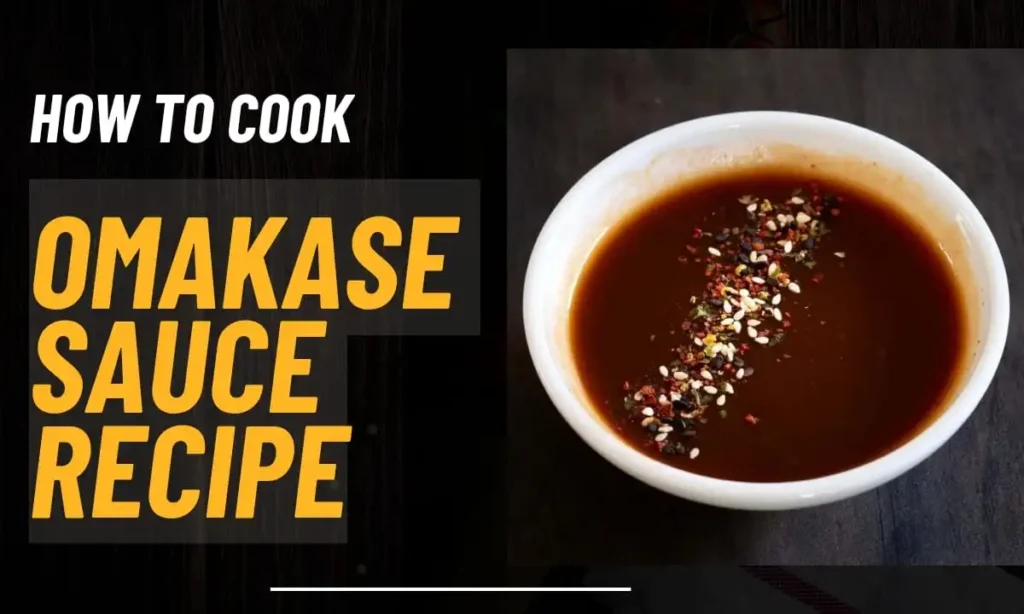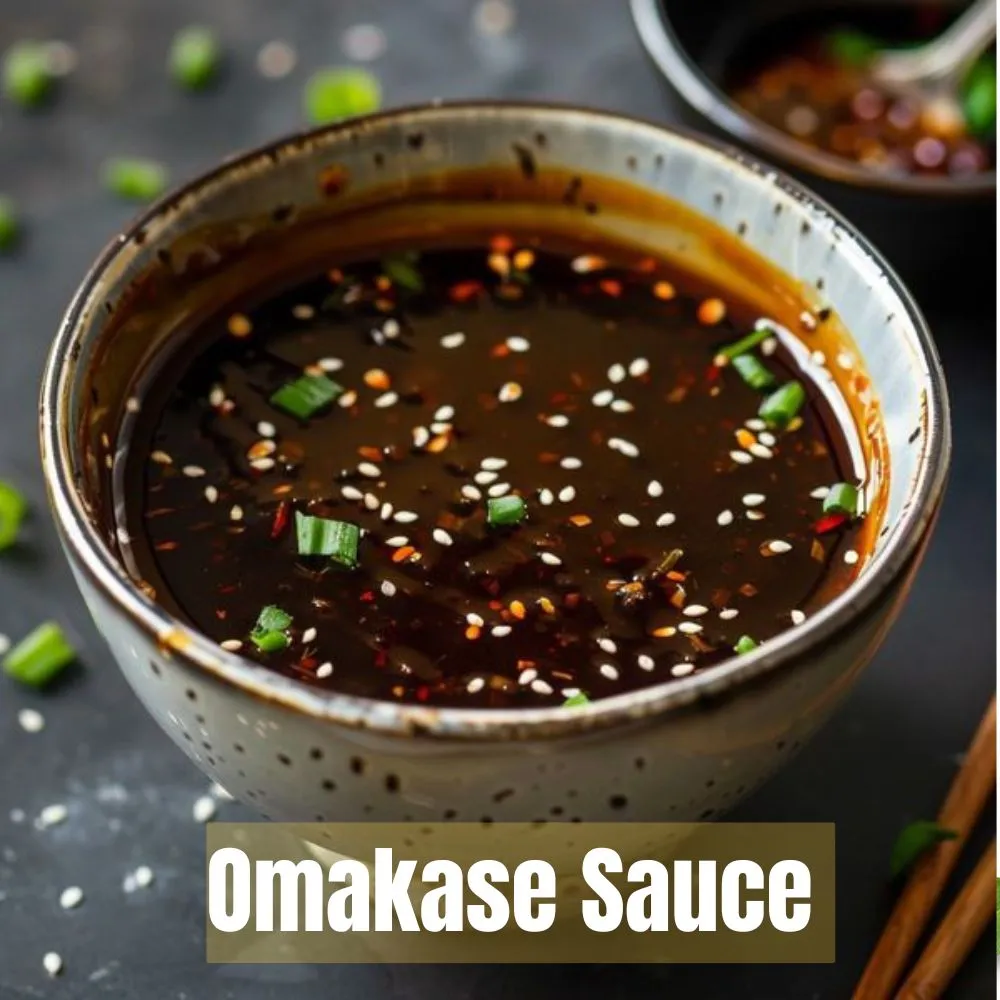
Introduction
If you’ve ever sat at a sushi counter and thought, “What makes these rolls taste so incredible?”—the answer is often the sauce. That’s exactly what inspired me to recreate this Omakase Sauce Recipe 2025 in my own kitchen.
I’ve always loved the artistry of omakase dining, where each dish feels like a gift from the chef. But the magic isn’t just in the fish or the rice—it’s in the subtle sauces that bring everything together.
This recipe has become one of my go-to sauce recipes, not just for sushi, but also for rice bowls, grilled salmon, and even roasted vegetables. And the best part? It takes less than 10 minutes to prepare.
» Ready to impress your guests with a sauce recipe (and yourself)?
And today, you’re about to learn how to recreate that elusive, umami-packed omakase sauce recipe right in your home kitchen.
Let’s dive in!
What Is Omakase Sauce?
“Omakase” (お任せ) translates to “I leave it up to you” — a term used when you trust the chef to serve you their best. In top-tier Japanese restaurants, sauces are often the unsung heroes that tie the entire culinary experience together.
This sauce is:
✅ Umami-rich from soy and dashi
✅ Aromatic with sesame oil, ginger, and garlic
✅ Bright & zesty thanks to citrus juice
✅ Perfectly balanced with a touch of sweetness
Think of it as Japan’s answer to an all-in-one dipping, glazing, and drizzling sauce.
What is Omakase Sauce made of?
» Omakase sauce typically combines soy sauce, mirin, sake, sugar, and optional flavors like yuzu or kombu for an umami-rich, balanced sauce perfect for sushi and sashimi.
Fun fact? Japan’s soy sauce market exceeded $2.4 billion in 2024, with premium artisanal varieties on the rise — meaning chefs (and now you!) have more flavor options than ever before.
Kitchen Equipment Required For Omakase Sauce
» Making Omakase Sauce Recipe 2025 doesn’t require fancy tools—just a few basics that most home kitchens already have:
» Mixing bowl – for whisking the sauce base together
» Whisk or fork – to blend soy, citrus, and aromatics smoothly
» Grater or microplane – for finely grating fresh ginger and garlic
» Measuring spoons & cups – to keep the balance of flavors just right
» Glass jar or airtight container – for storing the sauce in the refrigerator
» Optional Small saucepan – if you want to gently simmer the sauce for deeper infusion
Ingredients Required for Omakase Sauce Recipe
⭐ Traditional Core Ingredients
♥ Soy Sauce (shoyu) – The foundation of flavor
♥ Mirin – Adds sweetness and mild acidity
♥ Sake – Enhances depth and aroma
♥ Sugar – For balancing saltiness
🥢 Modern 2025 Additions
♥ Yuzu Juice – For citrus brightness
♥ Kombu (kelp) – Umami powerhouse, infused during simmering
♥ White Truffle Oil (optional) – For a luxurious twist
Extra Tip: For authentic taste and flavors, try out Koikuchi soy sauce or Tamari (gluten-free option).
Basic Ingredients for Omakase Sauce Recipe 2025
🍶 Primary Ingredients
♥ ½ cup Japanese soy sauce
– I suggest you use light soy sauce (Usukuchi) for a more enhanced flavor
♥ ¼ cup mirin
– Sweet rice wine adds mild sweetness and gloss
♥ ¼ cup dashi stock
– Traditional Japanese soup stock (use instant dashi powder mixed with water or homemade for best results)
♥ 1 tablespoon sugar
– Balances the saltiness, can adjust depending on taste preference
🐟 Umami Boosters
♥ 1 tablespoon bonito flakes (Katsuobushi)
– For deep umami, omit or replace with kombu for a vegan version
🍋 Aromatic Element
♥ ½ teaspoon yuzu zest (or lemon zest)
– Provides a fresh, citrusy aroma typical of fine omakase sauces
🍾 Optional Enhancements (Optional but Recommended)
♥ 1 teaspoon rice vinegar
– Adds a subtle brightness if you prefer a tangier finish
♥ Add a pinch of salt or light soy sauce to balance the taste
– Only if more seasoning is needed after tasting
♥ Optional: A Few drops of yuzu juice
– To add some citrus to the sauce.
Is truffle oil necessary in the Omakase Sauce Recipe?
» No, truffle oil is optional. It’s used to add luxury and depth, but the sauce tastes fantastic even without it, especially when paired with sushi or sashimi.
How to Make Omakase Sauce Recipe at Home 2025

Step 1️⃣ . Prepare Your Ingredients
Gather the following measured ingredients before you start:
♥ ½ cup Japanese soy sauce (premium recommended)
♥ ¼ cup mirin (sweet rice wine)
♥ ¼ cup dashi stock (can be freshly made or instant powder mixed with water)
♥ 1 tablespoon sugar (adjust to taste)
♥ 1 tablespoon bonito flakes (katsuobushi)
♥ ½ teaspoon yuzu zest (or lemon zest)
Optional: 1 teaspoon rice vinegar (adds brightness if desired)
Step 2️⃣ Make the Base
Place a small saucepan over medium heat.
Add:
♥ Soy sauce
♥ Mirin
♥ Dashi
♥ Sugar
♥ Stir it well with a whisk or spoon until the sugar fully dissolves.
» Important: Do not bring to a boil — a gentle simmer is ideal to preserve flavor.
Step 3️⃣ . Infuse the Umami Flavor
Add some bonito flakes to infuse the Umami flavor once the whole mixture is heated gently.
♥ Lower the heat to low.
♥ Let the bonito flakes simmer for 2 minutes. This enhances the deep umami flavor.
Step 4️⃣ Rest and Strain
Turn off the heat.
♥ Cover the pan or just let it sit undisturbed for 10 minutes. This allows the bonito to release its full flavor into the sauce.
♥ After resting, strain the sauce through a fine sieve or cheesecloth into a bowl to remove the bonito flakes.
Step 5️⃣ Final Touch: Add Citrus
Once strained, add the yuzu or lemon zest.
♥ Optional: Stir in 1 teaspoon rice vinegar for a subtle tang if you like a brighter flavor.
♥ Taste and adjust:
♥ More sugar if you prefer it sweet.
♥ More zest for brightness.
6️⃣ Cool, Serve and Enjoy!
♥ Let the sauce cool to room temperature.
♥ Pour into a small ceramic or glass bowl for presentation.
♥ It can be brushed onto sushi, drizzled over grilled fish, or used as a dip for sashimi.
♥ Transfer to a clean glass jar and refrigerate — lasts up to 2 weeks!
✅ Pro Tips
- For vegan version: Replace bonito flakes with kombu (kelp) to make a kombu-dashi-based omakase sauce.
- Texture Tip: If you want a thicker sauce, reduce it slightly longer over low heat after straining.
Is Omakase Sauce gluten-free?
♥ Traditional versions use soy sauce, which contains gluten. For a gluten-free option, use tamari or coconut aminos as a substitute for regular soy sauce.
Ingredient Substitutes for Omakase Sauce Recipe
Can’t find some ingredients? No worries — here are easy substitutes that still deliver rich flavor:
| Original Ingredient | Substitute | Notes |
|---|---|---|
| Soy Sauce (Shoyu) | Tamari (Gluten-Free) or Coconut Aminos | Tamari gives a richer, less salty flavor. Coconut Aminos adds sweetness. |
| Mirin | Rice Vinegar + Sugar (1 tbsp vinegar + ½ tsp sugar) | Mimics the sweet tang of mirin effectively. |
| Sake | Dry White Wine or Shaoxing Wine | Adds depth; use sparingly for balance. |
| Kombu (Kelp) | Dashi Powder or Shiitake Mushrooms | Adds umami in absence of kombu. |
| Yuzu Juice | Lemon + Orange Juice (50:50 mix) | For a citrusy zing when yuzu is unavailable. |
| Truffle Oil | Sesame Oil | Adds aroma, though not the same luxury profile as truffle. |
Can I make Omakase Sauce spicy?
Yes! Add a dash of wasabi, grated ginger, or mix with a little chili oil or sriracha if you prefer a spicy kick with your sushi or grilled dishes.
How to Use Omakase Sauce in 2025
🍱 Sushi & sashimi – drizzle for an instant umami lift
🐟 Grilled fish & seafood – perfect with salmon, shrimp, or tuna
🍗 Meats & poultry – works as a marinade or glaze for chicken or beef
🥬 Vegetables – elevate roasted or stir-fried veggies
🍚 Rice & noodles – transforms a simple bowl into a restaurant-worthy meal
🥟 Dumplings & tempura – use as a dipping sauce
Best Dishes to Pair with Omakase Sauce
♥ Sushi & Sashimi: Especially fatty fish like toro (tuna belly) or hamachi (yellowtail).
♥ Grilled Yakitori: Chicken skewers elevated with this savory sauce.
♥ Modern Fusion Ideas: Drizzle over poke bowls, rice salads, or even pan-seared scallops.
♥ According to culinary surveys, over 60% of diners say sauces elevate their overall sushi experience — don’t skip this step!
Tips for Perfecting Your Omakase Sauce Recipe!
🧂 Balance is Key: Too salty? Add a bit more mirin or sugar. Too sweet? Splash in extra soy.
🎏 Respect the Fish: Use sparingly on delicate white fish to avoid overpowering flavors.
🍽 Presentation Counts: Brush lightly over sushi with a bamboo brush or small spoon for that elegant restaurant touch.
Tips for Success
✔️ Use Premium Ingredients:
» High-quality soy sauce and mirin make a huge difference in flavor. The better the base, the better the final sauce.
✔️ Simmer Gently:
» Avoid boiling the sauce to preserve delicate aromatics, especially when using sake or kombu.
✔️ Balance to Taste:
» Taste and adjust! Add some sugar if it’s too salty. Want more tang? Increase the yuzu or citrus.
✔️ Brush, Don’t Drown:
» When serving with sushi or sashimi, brush a light layer. Too much sauce can overpower the fresh fish flavors.
✔️ Chill for Later:
» Omakase sauce can be stored in the fridge for up to 2 weeks. The flavors deepen over time.
🌿 Garnish, Storage & Serving Tips
🌱 Garnish: You can garnish Omakase sauce with sesame seeds or shredded nori
🫙 Storage: keep in a sealed jar in the fridge for up to 7 days
❄️ Serving: serve chilled or at room temperature—no reheating needed
📊 Nutrition Facts (per tablespoon)
♥ Calories: ~30
♥ Carbohydrates: 3g
♥ Protein: 1g
♥ Fat: 1g
♥ Sodium: ~400mg
(Values vary depending on ingredient substitutions.)
🔄 Variations & Substitutions
🌶️ Spicy twist – add chili oil or sriracha
🥄 Creamy dip – whisk in Japanese mayo
🍯 Miso depth – stir in ½ tsp miso paste
🧂 Low sodium – use reduced-salt soy sauce
What to Serve with Omakase Sauce
» Here are delicious pairing ideas for Omakase sauce to elevate your meals with this sauce:
🍣 Sushi & Sashimi
♥ Salmon, tuna, yellowtail, and scallops
♥ Lightly brush over nigiri or serve on the side for dipping
🔥 Grilled Proteins
♥ Yakitori (Japanese chicken skewers)
♥ Grilled Wagyu beef
♥ Charred eggplant or mushrooms for vegetarian options
🥗 Modern Dishes
♥ Poke bowls or grain bowls with tuna or tofu
♥ Drizzle steamed rice with a sprinkle of furikake
♥ Best for tempura vegetables or shrimp recipes.
Can I use Omakase Sauce for vegetarian dishes?
Definitely! It’s excellent over grilled vegetables, tofu, rice bowls, or even drizzled on salads for a savory, umami-packed boost.
Best Alternative Sauce Recipes for Omakase Sauce
1️⃣ Ponzu Sauce
» A light, citrus-based sauce made with soy sauce, rice vinegar, and yuzu or lemon juice. Perfect for sashimi, grilled fish, or salads. Adds a refreshing, tangy flavor.
2️⃣ Nikiri Sauce (Sweet Soy Glaze)
» A gently simmered mixture of soy sauce, mirin, sake, and sugar. Commonly brushed over sushi for a subtle sweetness and glossy finish.
3️⃣ Spicy Mayo
» A creamy, spicy sauce made by mixing Japanese mayonnaise with sriracha. Great for spicy tuna rolls, shrimp tempura rolls, or poke bowls.
4️⃣ Wasabi Soy Sauce
» Simple but bold. Just mix fresh wasabi with soy sauce for a sharp, spicy kick. Ideal for those who love heat with their sushi or sashimi.
5️⃣ Teriyaki Sauce
» Sweet, sticky, and savory. Made from soy sauce, mirin, sake, and sugar, this sauce pairs perfectly with grilled meats, yakitori, or roasted veggies.
Trader Joe’s Soyaki Sauce Recipe
Angry Crab Trifecta Sauce Recipe
» Each of these sauces can be used as a substitute or served alongside your omakase creations to add variety and elevate your dining experience.
Omakase Sauce recipe 2025
Ingredients
Equipment
Method
- In a small saucepan over medium heat, combine soy sauce, mirin, dashi, and sugar.
- Stir gently until the sugar dissolves and mixture is heated, do not boil.
- Add bonito flakes and simmer on low heat for 2 minutes.
- Turn off the heat and let it sit for 10 minutes to infuse.
- Strain the sauce into a clean bowl to remove bonito flakes.
- Add yuzu zest for aromatic brightness.
- Let cool slightly before serving or brushing on sushi, grilled fish, or vegetables.
Notes
- Make Ahead: Can be made 2-3 days in advance and stored in the refrigerator.
- Flavor Variations: Add a touch of wasabi or grated ginger for extra heat.
- Pairing Suggestions: Works exceptionally well with seared tuna, grilled eel, or drizzled over tamago (sweet egg omelet).
- Vegan Option: Use kombu dashi instead of bonito flakes.
Frequently Asked Questions
Nikiri Sauce vs Omakase Sauce?
Nikiri sauce is a sweet, reduced soy glaze used on sushi for mild sweetness. Omakase sauce is broader—a custom sauce by the chef, sometimes including truffle, yuzu, or other luxurious flavors for an elevated experience.
What dishes go well with Omakase Sauce?
Omakase sauce pairs beautifully with sushi, sashimi, grilled chicken skewers (yakitori), poke bowls, and even pan-seared scallops or vegetables.
What is the Japanese Omakase Sauce recipe?
Omakase sauce is a chef’s signature blend, often made with soy sauce, mirin, sake, sugar, and sometimes yuzu or truffle oil. It’s lightly brushed on sushi or sashimi to highlight the fish’s flavor without overpowering it.
What is the Traditional Omakase Sauce Recipe?
A traditional omakase sauce typically combines soy sauce, mirin, sake, and sugar, gently simmered for a balanced sweet-salty flavor. Some chefs add kombu or bonito for extra umami. It’s used lightly to complement premium sushi or sashimi.
How long does it take to make Omakase Sauce?
It usually takes around 10-15 minutes to prepare, including simmering and cooling. It’s a quick, rewarding recipe you can whip up before a meal.
Can I make the Omakase Sauce recipe without sake?
Absolutely. Substitute sake with dry white wine or skip it. You can adjust with extra mirin or a dash of water for balance.
My Final Conclusion
In my opinion, crafting your Omakase Sauce Recipe at home in 2025 is more than just mixing ingredients — it’s about bringing the art of Japanese dining into your home. Imagine impressing your guests with flavors typically reserved for Tokyo’s finest sushi bars!
» With premium soy sauce, a hint of yuzu, and that unmistakable umami hit, you can transform any meal into an unforgettable experience.
So, ready to tie on your apron, channel your inner sushi master, and elevate your next dinner? Trust me — this Omakase sauce recipe is your secret weapon.
» If you have any thoughts or suggestions about this Omakase sauce recipe, write to us in the comment section below!






